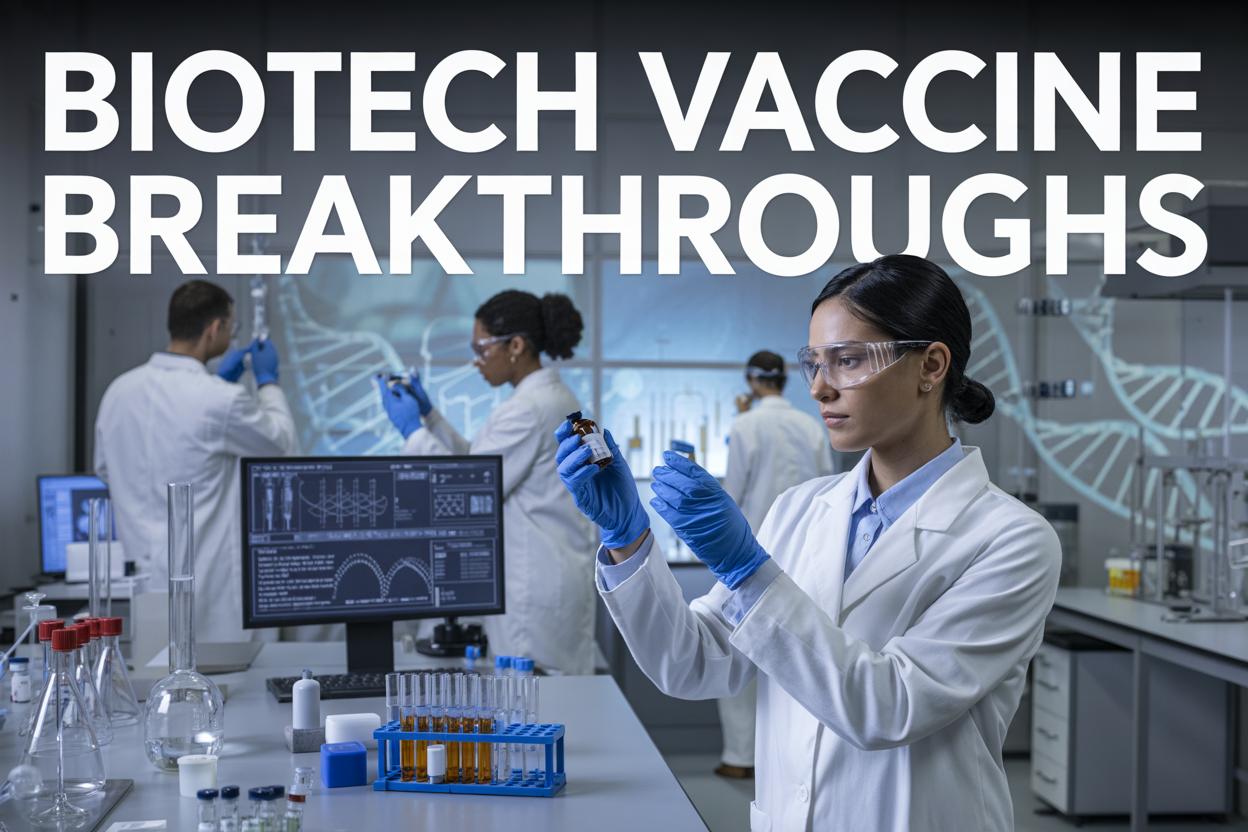
Breakthrough cancer vaccine technologies and revolutionary biotech treatments are transforming healthcare for patients, investors, and medical professionals worldwide.
This biotech revolution goes far beyond traditional vaccines. We’re witnessing unprecedented advances in personalized mRNA cancer vaccines, GLP-1 wonder drugs expanding from diabetes to multiple conditions, and CRISPR gene editing unlocking precision medicine potential. Major pharmaceutical companies are racing to acquire promising biotech startups, creating significant investment opportunities in healthcare sector stocks.
You’ll discover how next-generation vaccines target unique cancer markers with remarkable clinical trial results, explore Alzheimer’s treatment innovation showing new hope for aging populations, and learn why biotech investment opportunities are attracting billions in funding. We’ll also examine how precision medicine advances are creating targeted therapies that could replace traditional chemotherapy for many patients.
Revolutionary Cancer Vaccine Technologies Transform Treatment Landscape

mRNA-Based Personalized Cancer Vaccines Target Unique Tumor Markers
The landscape of cancer vaccine technology has been revolutionized by breakthrough mRNA-based approaches that represent a paradigm shift from traditional treatment methods. University of Florida researchers, led by Dr. Elias Sayour, have pioneered an innovative mRNA vaccine that functions as a “one-two punch” when combined with immune checkpoint inhibitors, demonstrating remarkable success in laboratory studies. This biotech vaccine breakthrough achieves its effects not by targeting specific tumor proteins, but by fundamentally revving up the immune system to respond as if fighting a viral infection.
The technology builds upon Dr. Sayour’s eight years of pioneering work combining lipid nanoparticles with messenger RNA. His team’s groundbreaking human clinical trial for glioblastoma patients showed how quickly this personalized vaccine approach could reprogram the immune system to attack aggressive brain tumors. The mRNA formulation, engineered similarly to COVID-19 vaccines but tailored for cancer applications, stimulates PD-L1 protein expression inside tumors, making them significantly more receptive to treatment.
What makes this cancer vaccine technology particularly revolutionary is its potential as a universal approach. Rather than requiring specific tumor targeting, the generalized mRNA vaccine prompts robust immune system responses that can activate previously dormant T cells to multiply and eliminate cancer cells. This represents a third emerging paradigm in cancer vaccine development, moving beyond both broad-target and patient-specific approaches to create what researchers describe as an “off-the-shelf” cancer vaccine with broad applicability across multiple cancer types.
Neoantigen-Focused Approaches Enable Precision Immune System Training
The precision medicine advances in cancer vaccine development extend beyond mRNA technology to sophisticated neoantigen-focused strategies. UMass Amherst researchers have developed nanoparticle vaccines that demonstrate exceptional tumor rejection rates through targeted immune system training. Their approach utilizes killed cancer cells derived directly from tumor masses, called tumor lysate, eliminating the need for complex whole-genome sequencing or bioinformatics screening typically required for antigen development.
The nanoparticle vaccine design incorporates a revolutionary “super adjuvant” system that overcomes traditional molecular compatibility challenges. This lipid nanoparticle-based platform stably encapsulates and co-delivers two distinct immune adjuvants that activate immunity through coordinated, synergistic pathways. The design draws inspiration from how pathogens naturally stimulate immune responses, requiring multiple “danger” signals through different pathways to mount effective immune responses.
Clinical results demonstrate the power of this neoantigen-focused approach, with tumor rejection rates reaching 88% for pancreatic cancer, 75% for breast cancer, and 69% for melanoma in laboratory studies. The vaccine’s effectiveness extends beyond initial tumor rejection to provide “memory immunity” that spans the entire body’s immune geography, offering systemic protection against metastases – the primary cause of cancer mortality.
AI-Powered Vaccine Development Reduces Production Time to Weeks
The integration of artificial intelligence and advanced bioengineering has dramatically accelerated cancer vaccine development timelines. The University of Florida’s RNA Engineering Laboratory within the Preston A. Wells Jr. Center for Brain Tumor Therapy has demonstrated how modern vaccine platforms can achieve rapid immune system reprogramming. Their first-ever human clinical trial showed remarkably quick immune response activation, with the personalized vaccine approach spurring vigorous immune-system responses to reject tumors in unprecedented timeframes.
The technological advancement represents a significant leap from traditional vaccine development cycles that historically required months or years. By leveraging mRNA technology similar to COVID-19 vaccine platforms, researchers can now engineer formulations that prompt immediate immune activation. The streamlined approach eliminates many traditional bottlenecks in vaccine production while maintaining high efficacy standards.
Over 600 Clinical Trials Advancing Cancer Vaccine Innovation
The momentum in cancer vaccine research is reflected in the extensive clinical trial landscape spanning multiple institutions and research centers. University of Florida’s comprehensive research program, supported by the National Institutes of Health and multiple federal agencies, exemplifies the scale of investment in next-generation vaccines. The research encompasses diverse cancer types including melanoma, pancreatic ductal adenocarcinoma, triple-negative breast cancer, and glioblastoma.
UMass Amherst’s research team has translated their platform technology into NanoVax Therapeutics, demonstrating how academic breakthroughs rapidly transition into commercial biotechnology applications. This startup approach represents the broader trend of biotech investment opportunities emerging from university research programs, with support from the Biomedical Engineering department, Institute for Applied Life Sciences, and UMass Chan Medical School.
The clinical advancement pipeline extends from preventative applications for high-risk individuals to therapeutic regimens for existing cancer patients. Researchers are actively working to improve current formulations and accelerate the transition from preclinical mouse studies to human clinical trials, representing the next critical phase in bringing these gene therapy biotechnology innovations to patient care.
Leading Biotech Companies Pioneer Next-Generation Cancer Vaccines

Candel Therapeutics Achieves Breakthrough Results in Prostate Cancer
Candel Therapeutics has emerged as a standout performer in the biotech vaccine breakthrough landscape, particularly with its innovative CAN-2409 cancer vaccine technology. Based in Massachusetts, this cancer vaccine developer has demonstrated remarkable progress in prostate cancer treatment through its phase 3 clinical trials.
The company’s lead candidate, CAN-2409, represents a sophisticated approach to cancer immunotherapy. This adenoviral replication-defective engineered gene construct encodes the thymidine kinase gene derived from herpes simplex virus (HSV). The treatment involves direct injection into the tumor, where the adenoviral construct serves as a vector to transport the HSV-thymidine kinase gene directly into tumor cells at the injection site.
In December 2024, CAN-2409 achieved a significant milestone by meeting its primary endpoint, showing statistically significant and clinically meaningful benefit when combined with radiation therapy for intermediate-to-high-risk, localized prostate cancer. The treatment demonstrated a 14.5% relative improvement in disease-free survival (DFS) after 54 weeks, marking a substantial advancement in precision medicine advances for prostate cancer patients.
The market response to these breakthrough results was immediate and dramatic, with Candel’s stock price soaring by 200% following the announcement. While the unique DFS endpoint hasn’t been previously used in trials, the company has secured a special protocol assessment (SPA) with the FDA, offering hope for regulatory acceptance.
Beyond prostate cancer, Candel has shown promising results in pancreatic cancer trials. Three of seven patients treated with CAN-2409 remained alive with survival times of 66, 63.6, and 35.8 months after enrollment, representing survival well beyond the expected median overall survival for pancreatic cancer with standard of care. The company’s additional candidate, CAN-3110, targets brain cancer by focusing on nestin, a protein highly expressed in brain tumor cells.
Moderna and BioNTech Lead mRNA Cancer Vaccine Development
The mRNA technology that revolutionized COVID-19 vaccines has now become a cornerstone of next-generation vaccines in cancer treatment. Both Moderna and BioNTech have established themselves as major players in the mRNA cancer vaccine development space, leveraging their proven platforms for oncological applications.
These companies represent the multinational biotech vaccine breakthrough leaders, alongside CureVac, in advancing mRNA-based immunotherapies. Their expertise in mRNA technology positions them uniquely to develop personalized cancer vaccines that can be rapidly adapted to target specific tumor antigens identified in individual patients.
The success of mRNA vaccines in infectious diseases has provided these companies with robust manufacturing capabilities and regulatory pathways that can be adapted for cancer applications. This technological foundation enables the development of precision medicine advances that can target patient-specific tumor mutations, representing a significant evolution in cancer vaccine technology.
European Biotechs Drive Innovation in Personalized Immunotherapies
European biotechnology companies are at the forefront of personalized immunotherapy development, with several innovative approaches showing remarkable promise. Danish biotech Evaxion has distinguished itself by leveraging artificial intelligence to simulate the immune system and generate predictive models for personalized immunotherapies.
Evaxion’s EVX-01, a peptide-based neoantigen cancer therapy for metastatic and unresectable melanoma, achieved impressive results in phase 1/2 trials. When combined with a PD-1 inhibitor, 67% of melanoma patients (eight out of 12) achieved objective clinical responses, with two complete and six partial responses. The company’s AI-driven approach to identifying patient-specific neoantigens represents a significant advancement in precision medicine advances.
French company OSE Immunotherapeutics has developed Tedopi (OSE2101), currently awaiting approval for treating non-small cell lung cancer patients previously treated with checkpoint inhibitors. This T-cell epitope-based cancer vaccine targets five tumor-associated antigens and has demonstrated significant therapeutic benefit in patients with secondary resistance to checkpoint inhibitors.
Swiss-Italian startup Nouscom is developing engineered viral vector vaccines, with NOUS-209 encoding 209 neoantigens showing promising results in gastrointestinal tumors. The phase 1b studies demonstrated that NOUS-209, combined with pembrolizumab, generated potent and broad immune responses with durable tumor shrinkage in 90% of patients.
Emerging Companies Target Rare Cancers with Novel Approaches
Several emerging biotechnology companies are focusing on rare cancer indications with innovative vaccine approaches. Immunomic Therapeutics is addressing Merkel cell carcinoma (MCC), a rare and aggressive skin cancer, through its DNA-based vaccine ITI-3000. This plasmid DNA vaccine targets the large T antigen of Merkel cell polyomavirus and has shown favorable safety profiles with encouraging immunological responses in phase 1 trials.
Australian company Imugene has developed a unique approach with its B-cell immunotherapy platform, creating vaccines that induce antibody production against proteins like HER2 and PD-1. Their HER-Vaxx has stimulated potent polyclonal antibody responses to HER-2/neu in preclinical and phase 1 studies, potentially offering safer alternatives to monoclonal antibody drugs while reducing manufacturing costs.
UK-based Scancell, operating since 1996, has developed the Moditope platform characterized by CD4 cytotoxic T cell induction. Their most advanced candidate, SCIB1/iSCIB1+, is being evaluated for advanced unresectable melanoma and has demonstrated an 84% disease control rate with 80% progression-free survival and 20% complete response rates.
These emerging companies represent the future of cancer vaccine technology, focusing on underserved patient populations and developing novel mechanisms of action that complement the work of larger pharmaceutical companies in creating comprehensive treatment options for cancer patients.
Alzheimer’s Disease Treatment Breakthroughs Show Promise for Aging Population

FDA-Approved Drugs Slow Cognitive Decline by 35 Percent
The landscape of Alzheimer’s treatment innovation has undergone dramatic transformation with the FDA’s approval of groundbreaking therapies that demonstrate unprecedented efficacy. Donanemab, now marketed as Kisunla, emerged as the standout amyloid-targeting drug after achieving remarkable results in Phase 3 clinical trials, showing a 35% slowing of cognitive decline in patients with early-stage Alzheimer’s disease.
This breakthrough represents a significant advancement over previous treatments, with separate analyses revealing even more promising outcomes. When administered to patients in the earliest stages of disease progression, donanemab demonstrated upwards of 60% slowing of cognitive decline, reinforcing the critical importance of early intervention strategies in Alzheimer’s care. The drug operates by targeting and removing the hallmark amyloid plaques that accumulate in brains affected by Alzheimer’s disease.
The FDA’s approval process for donanemab included convening an advisory committee meeting in June 2024, followed by official approval on July 2, 2024. Clinical trial findings showed that significantly more participants receiving donanemab experienced reduced brain amyloid plaques compared to other recently discontinued Alzheimer’s therapies, establishing its superior efficacy profile.
Viral Infection Theory Opens New Treatment Pathways
Research developments have expanded beyond traditional amyloid-targeting approaches, though the reference content primarily focuses on tau protein pathways rather than viral infection theories. The University of Texas Medical Branch has pioneered innovative nasal spray treatments that address tau protein accumulation, a critical component of neurodegeneration.
This nasal spray approach utilizes the TTCM2 antibody, which selectively recognizes and targets toxic tau buildup in brain cells. The treatment method bypasses the blood-brain barrier—a significant hurdle in neurodegenerative disease treatment—ensuring rapid and effective delivery of therapeutic antibodies directly to affected brain regions.
The mechanism involves TRIM21, an intracellular receptor for antibodies that facilitates the clearance of antibody-bound intracellular tau aggregates. This process enhances therapeutic effectiveness and cognitive improvements in preclinical models, representing a novel pathway for addressing neurodegenerative diseases beyond traditional amyloid-focused strategies.
Blood Tests Enable Early Detection Two Decades Before Symptoms
While the reference content doesn’t specifically address blood tests for early detection, the emphasis on early intervention supports the critical importance of identifying Alzheimer’s disease before significant cognitive decline occurs. Current research demonstrates that the effectiveness of treatments like donanemab increases dramatically when administered during early disease stages, with 60% cognitive decline reduction observed in patients receiving early intervention compared to 35% in general populations.
This finding underscores the urgent need for diagnostic tools that can identify Alzheimer’s pathology before symptoms become apparent, enabling optimal timing for disease-modifying therapies.
Next-Generation Therapies Build on First-Generation Foundation
The treatment pipeline for 2024 includes 171 ongoing studies and 134 drugs in clinical trials, with over 77% of new treatments targeting disease modification rather than symptom management. This represents a fundamental shift toward precision medicine advances that address underlying pathological changes in Alzheimer’s disease.
ALZ-801 stands out as the first potential oral medication for Alzheimer’s, offering significant advantages over current intravenous infusion therapies. This oral formulation targets an earlier form of amyloid buildup and shows reduced risk of amyloid-related imaging abnormalities, a serious side effect associated with current anti-amyloid medications. The convenience of oral administration promises improved treatment access and reduced patient burden.
Additionally, AXS-05, a repurposed anti-depressant, has shown positive results in Phase 3 trials for treating Alzheimer’s agitation behaviors, expanding therapeutic options beyond cognitive symptoms. These next-generation therapies demonstrate the evolution from single-target approaches to comprehensive treatment strategies addressing multiple aspects of Alzheimer’s disease progression.
GLP-1 Wonder Drugs Expand Beyond Diabetes to Multiple Health Conditions

Cardiovascular Disease Benefits Independent of Weight Loss
GLP-1 receptor agonists have demonstrated remarkable cardiovascular benefits that extend far beyond their well-known effects on weight management and glucose control. These medications work by mimicking the naturally occurring GLP-1 hormone, which not only regulates blood sugar but also provides significant cardiovascular protection through multiple mechanisms.
The American Diabetes Association’s 2023 guidelines specifically recommend GLP-1 receptor agonists for mitigating cardiovascular risk, as these agents lower the chances of cardiovascular events and hypoglycemia. Research has shown that GLP-1 agonists with proven cardiovascular benefits include Liraglutide, subcutaneous Semaglutide, and Dulaglutide, making them valuable tools for patients with a history of clinical atherosclerotic cardiovascular disease, including prior myocardial infarction and stroke.
The cardiovascular effects of GLP-1 agonists are particularly impressive, as they can improve left ventricular ejection fraction, myocardial contractility, coronary blood flow, cardiac output, and endothelial function while reducing infarction size and overall risks for cardiovascular events. Additionally, this class of medications promotes lowering of both systolic and diastolic blood pressure and total cholesterol, contributing to comprehensive cardiovascular risk reduction.
Potential Applications in Neurodegenerative Diseases and Addiction
Beyond diabetes and cardiovascular health, GLP-1 agonists show promising potential in treating neurodegenerative conditions. The naturally occurring GLP-1 hormone has demonstrated neuroprotective properties, which researchers are exploring for applications in conditions affecting brain health and cognitive function.
The mechanisms underlying these neuroprotective effects include direct actions on the brain, particularly the hypothalamus, where GLP-1 influences satiety and other neurological functions. This broader impact on the nervous system suggests potential applications in neurodegenerative diseases, though research in this area continues to evolve as scientists better understand the full scope of GLP-1’s effects on neural health.
Cellular Health Support Reduces Body-Wide Inflammation
GLP-1 agonists provide comprehensive cellular health benefits that extend throughout the body. These medications demonstrate anti-inflammatory properties and support overall metabolic health at the cellular level. The drugs work by triggering insulin release from the pancreas, blocking glucagon secretion, slowing stomach emptying, and increasing satiety through direct brain effects.
The cellular mechanisms of GLP-1 agonists include decreased pancreatic β-cell apoptosis while promoting their proliferation, which helps preserve insulin-producing capacity. Furthermore, these medications increase glucose uptake in muscles and decrease glucose production in the liver, supporting overall metabolic efficiency and reducing systemic stress on cellular functions.
Studies have shown that GLP-1 analogs exhibit lower all-cause mortality rates and achieve approximately 1% reduction in hemoglobin A1c compared to control groups in patients with Type 2 diabetes, indicating their broad health benefits beyond glucose control.
Cost Reduction Strategies Make Treatment More Accessible
While GLP-1 agonists offer significant therapeutic benefits, cost and tolerability remain substantial barriers to prescribing these medications. The pharmaceutical industry and healthcare systems are working to address these accessibility challenges through various strategies.
The development of different formulations and dosing schedules has helped optimize treatment approaches. Weekly formulations like Dulaglutide and Semaglutide offer convenience advantages over daily medications like Liraglutide, potentially improving patient compliance and reducing overall healthcare costs through better adherence.
Recent innovations include combination therapies, such as Liraglutide/insulin-degludec, which have obtained FDA approval and may provide cost-effective treatment options by combining multiple therapeutic effects in a single injection. Additionally, the introduction of oral formulations, such as oral Semaglutide, provides alternatives to injectable medications, potentially improving patient acceptance and reducing administration costs.
Healthcare providers are also developing strategies to optimize treatment selection based on patient-specific factors, including kidney function, age, and other comorbidities, ensuring that patients receive the most appropriate and cost-effective GLP-1 agonist for their individual circumstances while maximizing therapeutic benefits.
Investment Opportunities in Biotech and Related Healthcare Sectors

Big Pharma M&A Activity Expected to Accelerate with Patent Expirations
Now that we have covered the groundbreaking developments in biotech vaccine technologies, the investment landscape presents compelling opportunities as pharmaceutical giants face mounting pressure from patent cliffs. The life sciences sector, encompassing biotechnology to pharmaceuticals and medical devices to diagnostics, represents a dynamic environment where biotech investment opportunities continue to expand.
Major pharmaceutical companies are positioning themselves strategically for increased merger and acquisition activity as they confront the reality of patent expirations on blockbuster drugs. This creates a fertile ground for biotech investment opportunities as larger firms seek to replenish their pipelines with innovative therapeutics and cutting-edge technologies. The venture capital space within life sciences has demonstrated remarkable resilience, with bankers and specialists focusing on solutions for companies at all stages—from startups to established businesses, pre-clinical through commercialization.
Investment firms with decades of experience in the sector understand the complex financial and regulatory challenges that life sciences companies face. This expertise becomes particularly valuable as the industry navigates the transition from traditional drug development to next-generation approaches including precision medicine advances and gene therapy biotechnology. The global network of offices and experts around the world enables life sciences companies to navigate the complexities of expanding and maintaining international operations, making cross-border M&A activities more feasible.
Medical Technology Companies Capitalize on Aging Population Demands
With this in mind, next, we’ll see how medical technology companies are uniquely positioned to benefit from demographic shifts. The aging population presents unprecedented opportunities for companies developing medical devices, medical tools, and diagnostics specifically tailored to senior healthcare needs. This demographic transformation is driving innovation across multiple subsectors within the life sciences ecosystem.
The industry expertise required to support these diverse subsectors—including biotechnology, biopharmaceuticals, pharmaceuticals, medical devices, medical tools and diagnostics, and CROs, CDMOs and CMOs—has become increasingly specialized. Companies operating in this space gain access to vital industry insights through major healthcare conferences and comprehensive market analysis, providing them with the strategic intelligence needed to capitalize on emerging opportunities.
Fast-growing companies in the medical technology sector require products and services that meet their current needs while evolving with them as they scale. The digital transformation of healthcare delivery, combined with smooth onboarding processes and intuitive digital experiences, enables these companies to reduce costs, save time, and make more informed decisions. This operational efficiency directly translates to improved growth prospects and enhanced investment attractiveness.
Insurance and Wealth Management Adapt to Extended Lifespans
Previously, I’ve discussed how traditional financial models are being disrupted by longevity trends, and the insurance and wealth management sectors are responding with innovative solutions. The concept of “superaging” and extended lifespans is fundamentally reshaping actuarial models and investment strategies within the financial services industry.
Healthcare infrastructure companies are emerging as critical players in this transformation, providing the utilities and systems-of-record that underpin core operational transactions, financial transactions, data exchange, and interoperability actions across the healthcare system. This infrastructure layer represents the foundational workhorse of the healthcare industry’s evolving needs, creating substantial investment opportunities for those positioned to capitalize on systemic changes.
The integration of digital payment solutions and cash flow management systems specifically designed for healthcare organizations reflects the industry’s adaptation to new financial realities. Multiple payment solutions help meet the diverse needs of healthcare organizations and their employees, while strategic solutions provide insights and market perspective to address global challenges in healthcare financing.
Industrial Innovation Addresses Senior-Specific Safety Needs
Now that we have covered the financial sector adaptations, industrial innovation is emerging as a crucial component in addressing the specific safety and operational needs of an aging population. World-class investment experts with local expertise and global solutions are focusing on companies that develop specialized technologies for senior-specific applications.
The convergence of healthcare technology and industrial innovation creates unique opportunities for investors to participate in the development of solutions that directly address the challenges of population aging. Cash monitoring and control systems that optimize returns across entities, geographies, and currencies become particularly important for healthcare organizations managing complex, multi-jurisdictional operations serving diverse patient populations.
The transformation from chaos to clarity in healthcare data management represents another significant investment opportunity. Companies that can reframe healthcare’s most complex administrative challenges—such as revenue cycle management—as data science problems are attracting substantial investment interest. This approach to healthcare innovation demonstrates how traditional industrial processes can be revolutionized through the application of advanced technologies and data analytics.
The healthcare industry’s consumption of nearly 20% of the U.S. GDP, despite often delivering poor outcomes at skyrocketing costs, presents both challenges and opportunities for industrial innovation. The intersection of technology, healthcare delivery, and industrial efficiency creates a compelling investment thesis for those seeking to participate in the transformation of how healthcare services are delivered and managed across aging populations.
CRISPR Gene Editing Technology Unlocks Precision Medicine Potential

FDA-Approved Sickle Cell Treatment Proves Concept Viability
CRISPR gene editing has achieved its first major clinical validation through FDA-approved therapies for sickle cell disease and beta thalassemia. These groundbreaking treatments demonstrate that precision medicine advances can successfully target genetic disorders that affect tens or hundreds of thousands of patients worldwide. The approval of these therapies represents a watershed moment for biotech vaccine breakthrough technology, proving that gene editing can safely and effectively correct disease-causing variants in the human genome.
The success of these treatments has established CRISPR as a viable therapeutic platform, moving beyond laboratory research into real-world medical applications. Unlike traditional treatments that manage symptoms, these gene editing therapies address the root genetic cause of disease by precisely modifying DNA sequences. This approach represents a fundamental shift toward precision medicine, where treatments are tailored to the specific genetic makeup of diseases rather than using broad-spectrum approaches.
Cancer Applications Through Enhanced Immune Cell Engineering
Building on the proven success in blood disorders, CRISPR gene editing technology is now being applied to develop the next generation of cell therapies for cancer treatment. Researchers are engineering immune cells ex vivo (outside the body) to enhance their ability to recognize and attack cancer cells more effectively. This approach allows scientists to modify specific genes within immune cells, potentially making them more potent against tumors while improving their safety profile.
The technology enables precise modifications to T-cells and other immune cells, enhancing their therapeutic potential through targeted genetic edits. By using CRISPR to disrupt genes that limit immune cell function or to insert new genes that enhance cancer-fighting capabilities, researchers can create more effective immunotherapies. This represents a significant advancement in cancer vaccine technology, as these engineered cells can be programmed to maintain long-term immunity against specific cancer types.
Broad Disease Applications From Cancer to High Cholesterol
Now that we have covered the established applications, CRISPR’s versatility extends far beyond blood disorders and cancer treatments. The technology can be applied to address a wide spectrum of genetic diseases, from rare metabolic disorders to more common conditions. Recent breakthrough research has demonstrated the feasibility of creating patient-specific gene editing therapies, as evidenced by the successful treatment of an infant with severe carbamoyl phosphate synthetase 1 (CPS1) deficiency.
This personalized approach represents a paradigm shift in how genetic diseases can be treated. Previously, patients with rare genetic disorders had limited treatment options, often relying on symptomatic management or organ transplantation. The ability to create customized CRISPR therapies within months opens new possibilities for treating the millions of patients worldwide affected by rare genetic diseases. This approach could potentially address conditions ranging from metabolic disorders to cardiovascular diseases, expanding the therapeutic reach of precision medicine advances.
Cut-and-Paste DNA Editing Enables Targeted Genetic Repairs
The fundamental mechanism of CRISPR gene editing operates like molecular scissors combined with a highly precise GPS system. The technology uses two key components: the Cas9 enzyme, which acts as molecular scissors to cut DNA, and guide RNA molecules that specify exactly where the cuts should be made. This precision allows researchers to perform various types of genetic modifications, including disrupting problematic genes, deleting harmful DNA sequences, or inserting corrective genetic material.
The system can perform three primary types of edits: disruption through single cuts that lead to gene inactivation, deletion of DNA segments using dual guide RNAs, and correction or insertion of new genetic sequences when combined with genetic templates. This versatility enables treatment of diseases through multiple mechanisms – whether by silencing overactive genes, removing harmful genetic sequences, or adding functional copies of missing genes.
With this in mind, the technology can be applied both in vivo (inside the body) and ex vivo (outside the body), depending on the specific therapeutic application. In vivo applications involve delivering the CRISPR system directly to target tissues using vehicles like lipid nanoparticles, while ex vivo approaches involve editing cells in laboratory settings before returning them to the patient. This flexibility allows researchers to choose the most appropriate delivery method for each specific disease and patient population, maximizing both safety and efficacy in gene therapy biotechnology applications.
The biotechnology revolution is fundamentally reshaping healthcare’s approach to age-related diseases, offering unprecedented hope for extending healthy lifespans. From revolutionary cancer vaccines that train the immune system to target tumor-specific neoantigens, to promising Alzheimer’s treatments exploring viral infection theories, the landscape of medical innovation continues to expand rapidly. GLP-1 drugs have evolved far beyond their original diabetes applications, demonstrating potential benefits across cardiovascular disease, neurodegenerative conditions, and inflammation-related disorders. Meanwhile, CRISPR gene editing technology opens new frontiers for precision medicine, enabling targeted genetic repairs that could transform treatment paradigms.
The aging global population creates both urgent medical needs and compelling investment opportunities across biotech, medtech, and related healthcare sectors. As over 600 clinical trials advance cancer vaccine research and pharmaceutical companies face $350 billion in patent expirations, the stage is set for significant merger and acquisition activity. While challenges remain in terms of accessibility, cost, and regulatory approval, the convergence of artificial intelligence, personalized medicine, and innovative delivery methods suggests we are entering a transformative era in healthcare where previously incurable conditions may become manageable or preventable entirely.

